The Effect of Incorporating Ultra-Fine Spherical Particles on Rheology and Engineering Properties of Commercial Ultra-High-Performance Grout
Abstract
:1. Introduction
2. Materials and Methods
2.1. Materials
2.2. Mix Design and Testing Methods
- 180 s at low speed (136 rpm);
- 90 s at intermediate speed (281 rpm);
- 45 s at high speed (550 rpm).
3. Results and Discussion
3.1. Slump-Flow Test
3.2. Compressive Strength
3.3. Flexural Strength and Abrasion Resistance
3.4. Volumetric Stability
3.5. Permeability
3.6. Observations of Microstructure
4. Conclusions
Author Contributions
Funding
Institutional Review Board Statement
Informed Consent Statement
Data Availability Statement
Acknowledgments
Conflicts of Interest
Abbreviations
| ASTM | American Society for Testing and Material |
| C-S-H | calcium-silicate-hydrates |
| MIP | mercury intrusion porosimetry |
| OPC | ordinary Portland concrete |
| PS | Polycarboxylate superplasticizer |
| RCPT | rapid chloride permeability test |
| RUFA | reactive ultra-fine fly ash |
| SEM | scanning electron microscope |
| UHPC | ultra-high-performance concrete |
| UHPG | ultra-high-performance grout |
| w/b | water-to-binder ratio |
References
- Liu, J.; Jin, H.; Zhao, X.; Wang, C. Effect of Multi-Walled Carbon Nanotubes on Improving the Toughness of Reactive Powder Concrete. Materials 2019, 12, 2625. [Google Scholar] [CrossRef] [Green Version]
- Wan, L.; Wendner, R.; Liang, B.; Cusatis, G. Analysis of the behavior of ultra high performance concrete at early age. Cem. Concr. Compos. 2016, 74, 120–135. [Google Scholar] [CrossRef] [Green Version]
- Wu, Z.; Shi, C.; Khayat, K.H. Investigation of mechanical properties and shrinkage of ultra-high performance concrete: Influence of steel fiber content and shape. Compos. B Eng. 2019, 174, 107021. [Google Scholar] [CrossRef]
- Wu, Z.; Khayat, K.H.; Shi, C.; Tutikian, B.F.; Chen, Q. Mechanisms underlying the strength enhancement of UHPC modified with nano-SiO2 and nano-CaCO3. Cem. Concr. Compos. 2021, 119, 103992. [Google Scholar] [CrossRef]
- Pourjahanshahi, A.; Madani, H. Chloride diffusivity and mechanical performance of UHPC with hybrid fibers under heat treatment regime. Mater. Today Commun. 2021, 26, 102146. [Google Scholar] [CrossRef]
- Wille, K.; Kim, D.J.; Naaman, A.E. Strain-hardening UHP-FRC with low fiber contents. Mater. Struct. 2011, 44, 583–598. [Google Scholar] [CrossRef]
- Li, Y.; Tan, K.H.; Yang, E.H. Influence of aggregate size and inclusion of polypropylene and steel fibers on the hot permeability of ultra-high performance concrete (UHPC) at elevated temperature. Constr. Build. Mater. 2018, 169, 629–637. [Google Scholar] [CrossRef]
- Bajaber, M.A.; Hakeem, I.Y. UHPC evolution, development, and utilization in construction: A review. J. Mater. Res. Technol. 2021, 10, 1058–1074. [Google Scholar] [CrossRef]
- Abbas, S.; Nehdi, M.L.; Saleem, M.A. Ultra-high performance concrete: Mechanical performance, durability, sustainability and implementation challenges. Int. J. Concr. Struct. Mater. 2016, 10, 271–295. [Google Scholar] [CrossRef] [Green Version]
- Alkaysi, M.; El-Tawil, S.; Liu, Z.; Hansen, W. Effects of silica powder and cement type on durability of ultra high performance concrete (UHPC). Cem. Concr. Compos. 2016, 66, 47–56. [Google Scholar] [CrossRef]
- Guo, H.; Tang, Z.; Liu, Q.; Xu, J.; Wang, M.; Liang, R.; Sun, G. Ultra-stable anti-washout cement grout achieved by super water absorbing villus-like nanocomposite hydrogel. Constr. Build. Mater. 2021, 301, 124035. [Google Scholar] [CrossRef]
- Lacerda, M.M.S.; da Silva, T.J.; Alva, G.M.S.; de Lima, M.C.V. Influence of the vertical grouting in the interface between corbel and beam in beam-to-column connections of precast concrete structures–an experimental analysis. Eng. Struct. 2018, 172, 201–213. [Google Scholar] [CrossRef]
- Vasumithran, M.; Anand, K.B.; Sathyan, D. Effects of fillers on the properties of cement grouts. Constr. Build. Mater. 2020, 246, 118346. [Google Scholar] [CrossRef]
- Wang, Z.; Zhu, J.; Wang, J.; Zhao, G.; Sun, S.; Zhang, J. Experimental study on a novel UHPC grout-filled pipe sleeve with mechanical interlocking for large-diameter deformed bars. Eng. Struct. 2021, 226, 111358. [Google Scholar] [CrossRef]
- He, S.; Mosallam, A.S.; Fang, Z.; Zou, C.; Feng, W.; Su, J. Experimental study on CFSC encased shear connectors in steel-concrete composite joints with UHPC grout. Constr. Build. Mater. 2018, 173, 638–649. [Google Scholar] [CrossRef]
- Tan, H.; Guo, Y.; Zou, F.; Jian, S.; Ma, B.; Zhi, Z. Effect of borax on rheology of calcium sulphoaluminate cement paste in the presence of polycarboxylate superplasticizer. Constr. Build. Mater. 2017, 139, 277–285. [Google Scholar] [CrossRef]
- Belhadi, R.; Govin, A.; Grosseau, P. Influence of polycarboxylate superplasticizer, citric acid and their combination on the hydration and workability of calcium sulfoaluminate cement. Cem. Concr. Res. 2021, 147, 106513. [Google Scholar] [CrossRef]
- Zhang, K.; Pan, L.; Li, J.; Lin, C. What is the mechanism of the fiber effect on the rheological behavior of cement paste with polycarboxylate superplasticizer? Constr. Build. Mater. 2021, 281, 12542. [Google Scholar] [CrossRef]
- Soliman, N.A.; Tagnit-Hamou, A. Development of ultra-high-performance concrete using glass powder-Towards ecofriendly concrete. Constr. Build. Mater. 2016, 125, 600–612. [Google Scholar] [CrossRef]
- Wang, X.; Yu, R.; Shui, Z.; Zhao, Z.; Song, Q.; Yang, B.; Fan, D. Development of a novel cleaner construction product: Ultra-high performance concrete incorporating lead-zinc tailings. J. Clean. Prod. 2018, 196, 172–182. [Google Scholar] [CrossRef]
- Huang, W.; Kazemi-Kamyab, H.; Sun, W.; Scrivener, K. Effect of replacement of silica fume with calcined clay on the hydration and microstructural development of eco-UHPFRC. Mater. Des. 2017, 121, 36–46. [Google Scholar] [CrossRef]
- Lee, C.L.; Huang, R.; Lin, W.T.; Weng, T.L. Establishment of the durability indices for cement-based composite containing supplementary cementitious materials. Mater. Des. 2012, 37, 28–39. [Google Scholar] [CrossRef]
- Komabayashi, T.; Spångberg, L.S. Comparative analysis of the particle size and shape of commercially available mineral trioxide aggregates and Portland cement: A study with a flow particle image analyzer. J. Endod. 2008, 34, 94–98. [Google Scholar] [CrossRef] [PubMed]
- Mehta, A.; Ashish, D.K. Silica fume and waste glass in cement concrete production: A review. J. Build. Eng. 2020, 29, 100888. [Google Scholar] [CrossRef]
- Siddique, R. Utilization of silica fume in concrete: Review of hardened properties. Resour. Conserv. Recycl. 2011, 55, 923–932. [Google Scholar] [CrossRef]
- Lin, W.T. Reactive ultra-fine fly ash as an additive for cement-based materials. Mater. Today Commun. 2020, 25, 101466. [Google Scholar] [CrossRef]
- Chen, K.; Lin, W.T.; Liu, W. Effect of NaOH concentration on properties and microstructure of a novel reactive ultra-fine fly ash geopolymer. Adv. Powder Technol. 2021, 32, 2929–2939. [Google Scholar] [CrossRef]
- Lin, W.T.; Lin, K.L.; Korniejenko, K.; Fiala, L. Comparative analysis between fly ash geopolymer and reactive ultra-fine fly ash geopolymer. Int. J. Eng. Technol. Innov. 2021, 11, 161–170. [Google Scholar] [CrossRef]
- Shin, H.O.; Yoo, D.Y.; Lee, J.H. Development of 300 MPa ultra-high-strength mortar through a special curing regime. Constr. Build. Mater. 2018, 20, 312–320. [Google Scholar] [CrossRef]
- Meng, W.; Khayat, K.H. Improving flexural performance of ultra-high-performance concrete by rheology control of suspending mortar. Compos. B Eng. 2017, 117, 26–34. [Google Scholar] [CrossRef]
- Liu, X.; Wang, Z.; Zheng, Y.; Cui, S.; Lan, M.; Li, H.; Zhu, J.; Liang, X. Preparation, Characterization and performances of powdered polycarboxylate superplasticizer with bulk polymerization. Materials 2014, 29, 6169–6183. [Google Scholar]
- Chen, H.J.; Yu, Y.L.; Tang, C.W. Mechanical properties of ultra-high performance concrete before and after exposure to high temperatures. Materials 2020, 7, 770. [Google Scholar] [CrossRef] [Green Version]
- John, S.K.; Nadir, Y.; Girija, K. Effect of source materials, additives on the mechanical properties and durability of fly ash and fly ash-slag geopolymer mortar: A review. Constr. Build. Mater. 2021, 280, 122443. [Google Scholar] [CrossRef]
- Alsalman, A.; Dang, C.N.; Hale, W.M. Development of ultra-high-performance concrete with locally available materials. Constr. Build. Mater. 2017, 133, 135–145. [Google Scholar] [CrossRef]
- Larsen, I.L.; Thorstensen, R.T. The influence of steel fibres on compressive and tensile strength of ultra-high-performance concrete: A review. Constr. Build. Mater. 2020, 256, 119459. [Google Scholar] [CrossRef]
- Liang, X.; Wu, C.; Su, Y.; Chen, Z.; Li, Z. Development of ultra-high-performance concrete with high fire resistance. Constr. Build. Mater. 2018, 179, 400–412. [Google Scholar] [CrossRef]
- Arora, A.; Yao, Y.; Mobasher, B.; Neithalath, N. Fundamental insights into the compressive and flexural response of binder-and aggregate-optimized ultra-high-performance concrete (UHPC). Cem. Concr. Compos. 2019, 98, 1–13. [Google Scholar] [CrossRef]
- Pyo, S.; Abate, S.Y.; Kim, H. Abrasion resistance of ultra high performance concrete incorporating coarser aggregate. Constr. Build. Mater. 2018, 165, 11–16. [Google Scholar] [CrossRef]
- Hasnat, A.; Ghafoori, N. Abrasion resistance of ultra-high-performance concrete for railway sleepers. Urban Rail Transit 2021, 7, 101–116. [Google Scholar] [CrossRef]
- Lin, W.T.; Wu, Y.C.; Cheng, A.; Chao, S.J.; Hsu, H.M. Engineering properties and correlation analysis of fiber cementitious materials. Materials 2014, 7, 7423–7435. [Google Scholar] [CrossRef] [Green Version]
- Glasser, F.P.; Zhang, L. High-performance cement matrices based on calcium sulfoaluminate-belite compositions. Cem. Concr. Res. 2001, 21, 1881–1886. [Google Scholar] [CrossRef]
- Sharp, J.P.; Lawrence, C.D.; Yang, R. Calcium sulfoaluminate cements—Low-energy cements, special cements or what? Adv. Cem. Res. 1999, 11, 3–13. [Google Scholar] [CrossRef]
- Aranda, M.A.G.; de La Torre, A.G. Sulfoaluminate cement. In Eco-Efficient Concrete; Pachego-Torgal, F., Jalali, S., Labrincha, J., John, V.M., Eds.; Woodhead Publishing: Cambridge, UK, 2013; p. 488. [Google Scholar]
- Kurdowsky, W.; Thiel, A. On the role of free calcium oxide in expansive cements. Cem. Concr. Res. 1981, 11, 29–40. [Google Scholar] [CrossRef]
- Gastaldi, D.; Paul, G.; Marchese, L.; Irico, S.; Boccaleri, E.; Mutke, S.; Buzzi, L.; Canonico, F. Hydration products in sulfoaluminate cements: Evaluation of amorphous phases by XRD/solid-state NMR. Cem. Concr. Res. 2016, 90, 162–173. [Google Scholar] [CrossRef]
- Wang, X.; Hou, P.; Yu, J.; Zhou, X.; Cheng, X. The effects of silica fume on C3A hydration. Constr. Build. Mater. 2020, 250, 118766. [Google Scholar] [CrossRef]
- Sakai, E.; Miyahara, S.; Ohsawa, S.; Lee, S.H.; Daimon, M. Hydration of fly ash cement. Cem. Concr. Res. 2005, 35, 1135–1140. [Google Scholar] [CrossRef]
- Moghaddam, F.; Sirivivatnanon, V.; Vessalas, K. The effect of fly ash fineness on heat of hydration, microstructure, flow and compressive strength of blended cement pastes. Case Stud. Constr. Mater. 2019, 10, e00218. [Google Scholar] [CrossRef]
- Xie, T.; Fang, C.; Mohamad Ali, M.S.; Visintin, P. Characterizations of autogenous and drying shrinkage of ultra-high performance concrete (UHPC): An experimental study. Cem. Concr. Compos. 2018, 91, 156–173. [Google Scholar] [CrossRef]
- Soliman, A.; Nehdi, M. Effect of partially hydrated cementitious materials and superabsorbent polymer on early-age shrinkage of UHPC. Constr. Build. Mater. 2013, 41, 270–275. [Google Scholar] [CrossRef]
- Collepardi, M.; Borsoi, A.; Collepardi, S.; Olagot, J.J.O.; Troli, R. Effects of shrinkage reducing admixture in shrinkage compensating concrete under non-wet curing conditions. Cem. Concr. Compos. 2005, 27, 704–708. [Google Scholar] [CrossRef]
- Anshuang, S.; Ling, Q.; Shoujie, Z.; Jiayang, Z.; Zhaoyu, L. Effects of shrinkage reducing agent and expansive admixture on the volume deformation of ultrahigh performance concrete. Adv. Mater. Sci. Eng. 2017, 2017, 6384859. [Google Scholar] [CrossRef] [Green Version]
- ASTM C 1202-19. Standard Test Method for Electrical Indication of Concrete’s Ability to Resist Chloride Ion Penetration; ASTM International: West Conshohocken, PA, USA, 2019. [Google Scholar]
- Mosavinejad, S.H.G.; Langaroudi, M.A.M.; Barandoust, J.; Ghanizadeh, A. Electrical and microstructural analysis of UHPC containing short PVA fibers. Constr. Build. Mater. 2020, 235, 117448. [Google Scholar] [CrossRef]
- Mohd Faizal, M.J.; Hamidah, M.S.; Muhd Norhasri, M.S.; Noorli, I.; Mohamad Ezad Hafez, M.P. Chloride Permeability of Nanoclayed Ultra-High Performance Concrete; Hassan, R., Yusoff, M., Alisibramulisi, A., Mohd Amin, N., Ismail, Z., Eds.; Springer: Singapore, 2015. [Google Scholar]
- Tai, Y.S.; El-Tawil, S.; ASCE, F.; Meng, B.; Hansen, W. Parameters influencing fluidity of UHPC and their effect on mechanical and durability properties. J. Mater. Civ. Eng. 2020, 32, 04020298. [Google Scholar] [CrossRef]
- Teng, S.; Afroughsabet, V.; Ostertag, C.P. Flexural behavior and durability properties of high performance hybrid-fiber-reinforced concrete. Constr. Build. Mater. 2018, 182, 504–515. [Google Scholar] [CrossRef]
- Vincler, J.P.; Sanchez, T.; Turgeon, V.; Conciatori, D.; Sorelli, L. A modified accelerated chloride migration tests for UHPC and UHPFRC with PVA and steel fibers. Cem. Concr. Res. 2019, 117, 38–44. [Google Scholar] [CrossRef]
- Madani, H.; Norouzifar, M.N.; Rostami, J. The synergistic effect of pumice and silica fume on the durability and mechanical characteristics of eco-friendly concrete. Constr. Build. Mater. 2018, 174, 356–368. [Google Scholar] [CrossRef]
- Li, P.P.; Brouwers, H.J.H.; Chen, W.; Yu, Q. Optimization and characterization of high-volume limestone powder in sustainable ultra-high performance concrete. Constr. Build. Mater. 2020, 242, 118112. [Google Scholar] [CrossRef]
- Huang, W.; Kazemi-Kamyab, H.; Sun, W.; Scrivener, K. Effect of cement substitution by limestone on the hydration and microstructural development of ultra-high performance concrete (UHPC). Cem. Concr. Compos. 2017, 77, 86–101. [Google Scholar] [CrossRef]
- Ren, M.; Wen, X.; Gao, X.; Liu, Y. Thermal and mechanical properties of ultra-high performance concrete incorporated with microencapsulated phase change material. Constr. Build. Mater. 2021, 273, 121714. [Google Scholar] [CrossRef]
- Yujing, L.; Wenhua, Z.; Fan, W.; Peipei, W.; Weizhao, Z.; Fenghao, Y. Static mechanical properties and mechanism of C200 ultra-high performance concrete (UHPC) containing coarse aggregates. Sci. Eng. Compos. Mater. 2020, 27, 186–195. [Google Scholar] [CrossRef]
- Jing, R.; Liu, Y.; Yan, P. Uncovering the effect of fly ash cenospheres on the macroscopic properties and microstructure of ultra high-performance concrete (UHPC). Constr. Build. Mater. 2021, 286, 122977. [Google Scholar] [CrossRef]
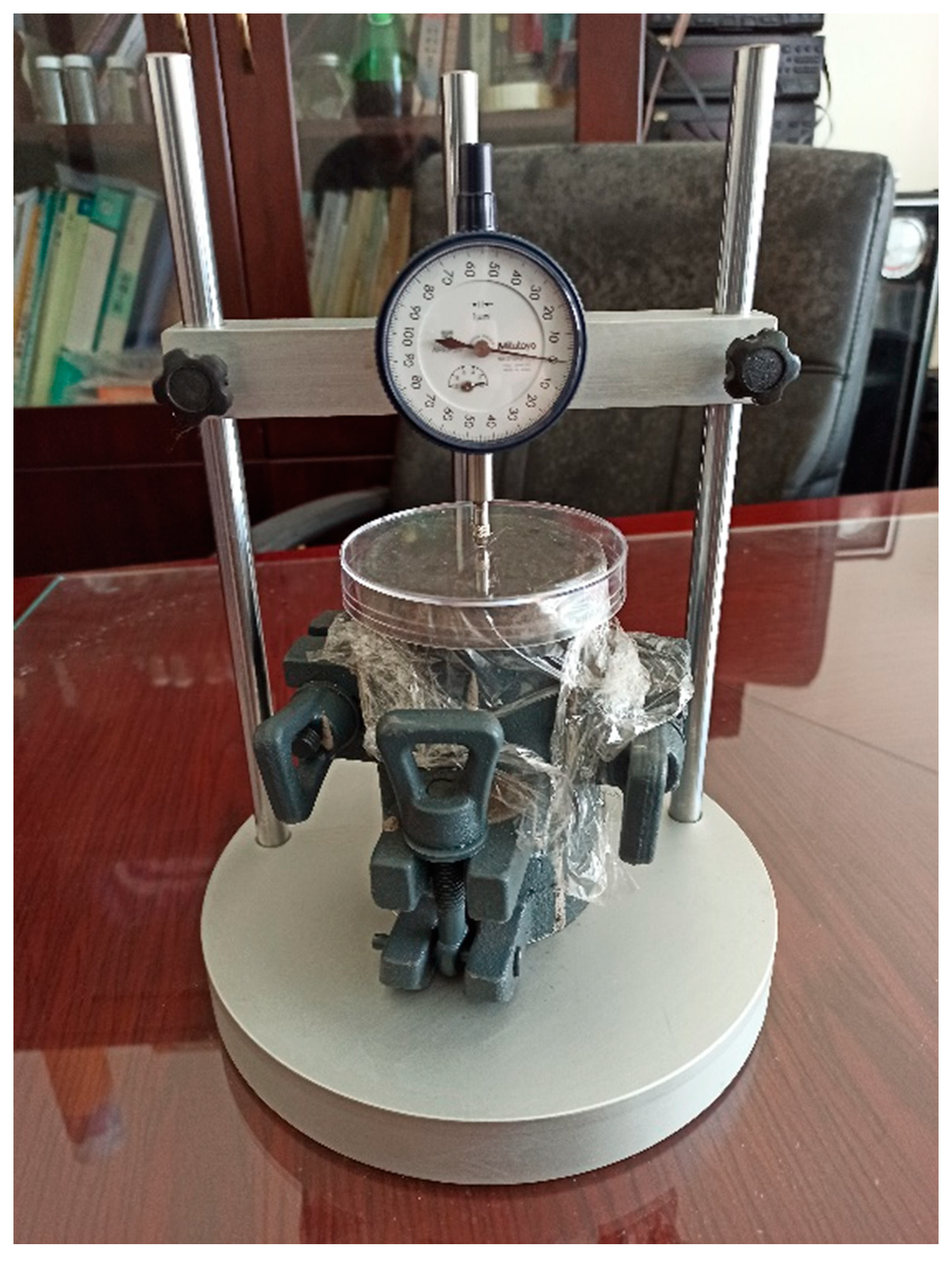

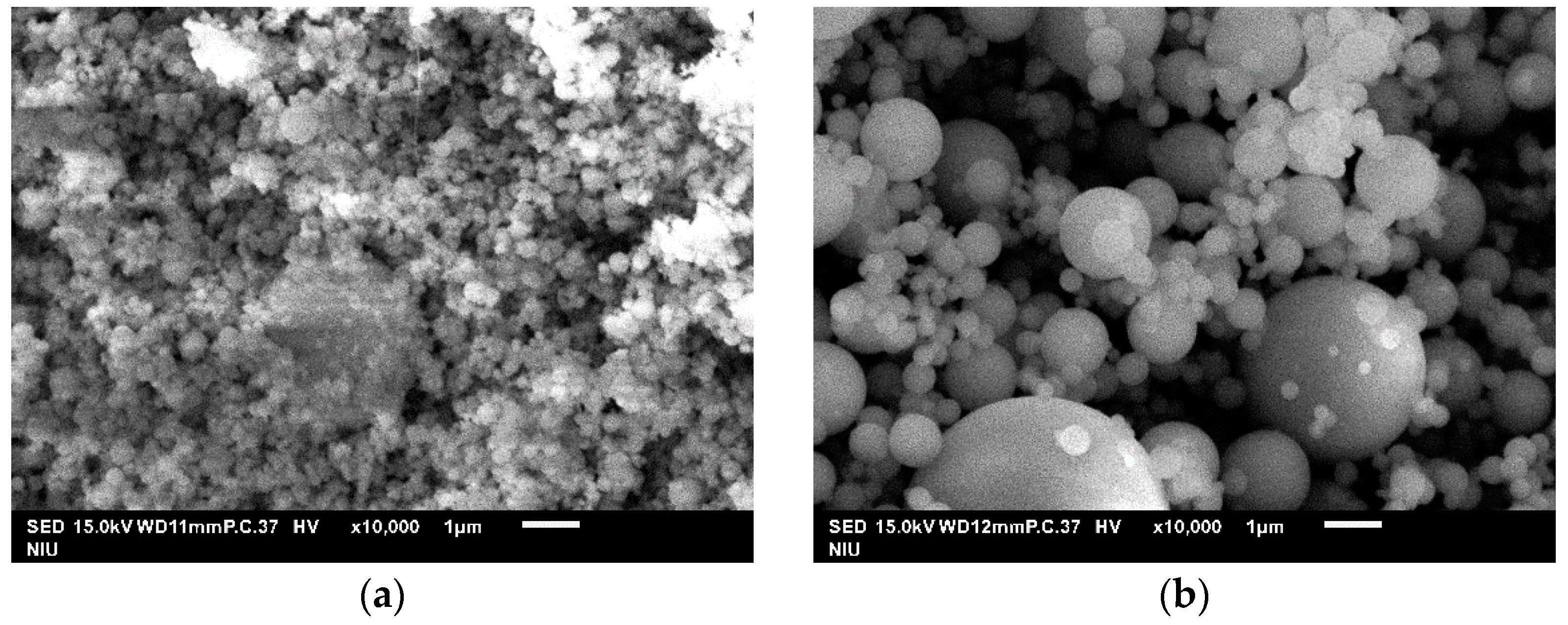

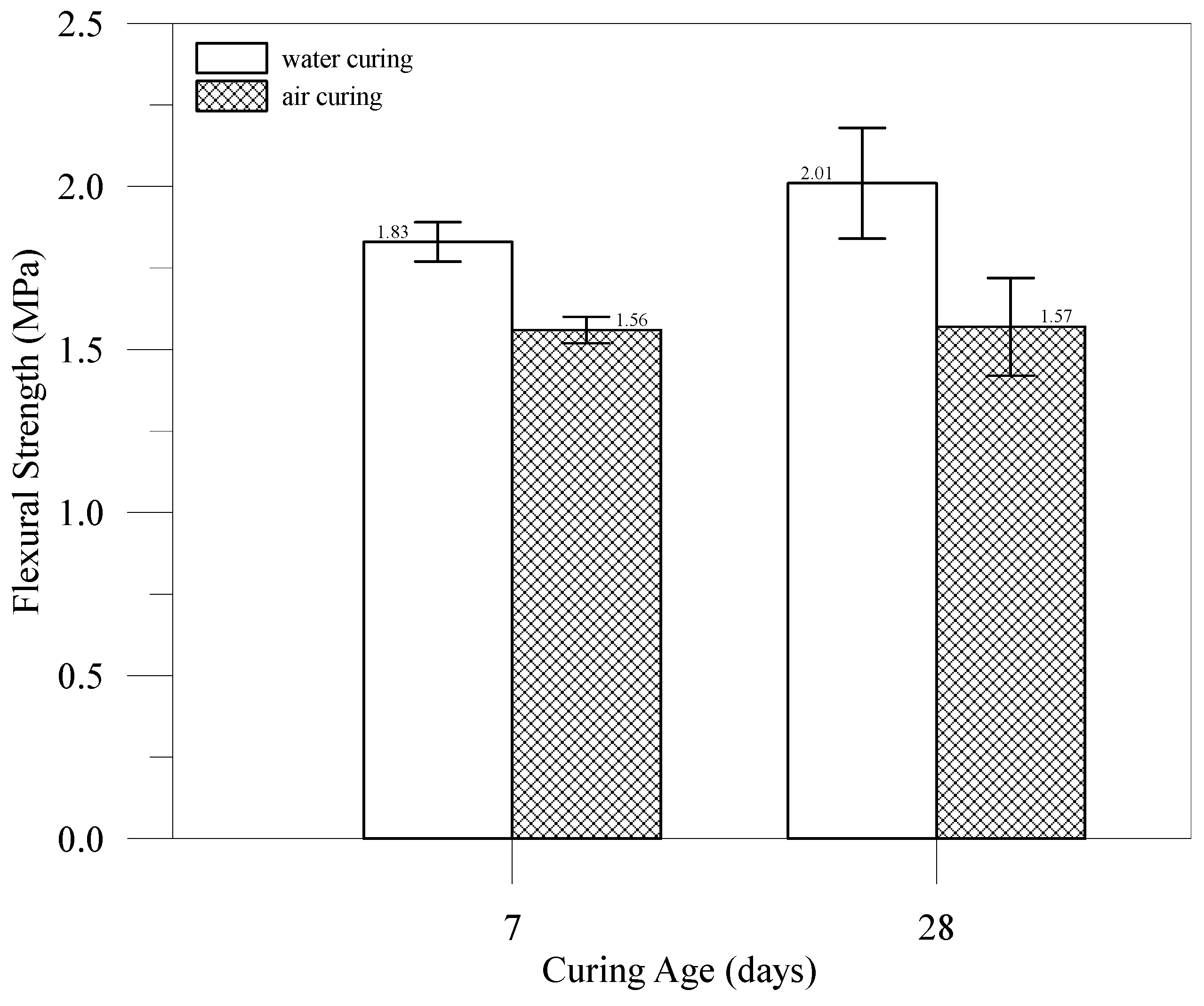
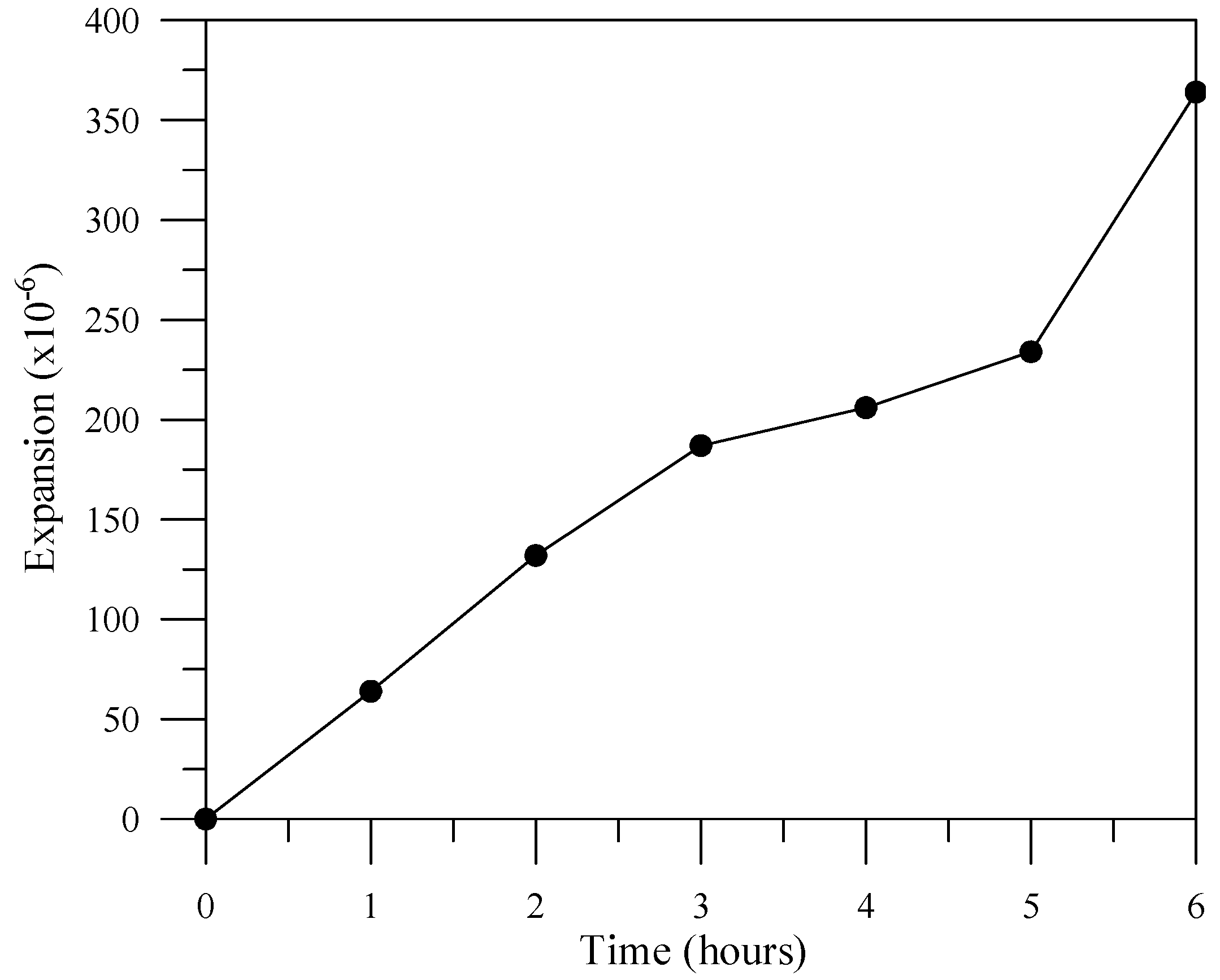

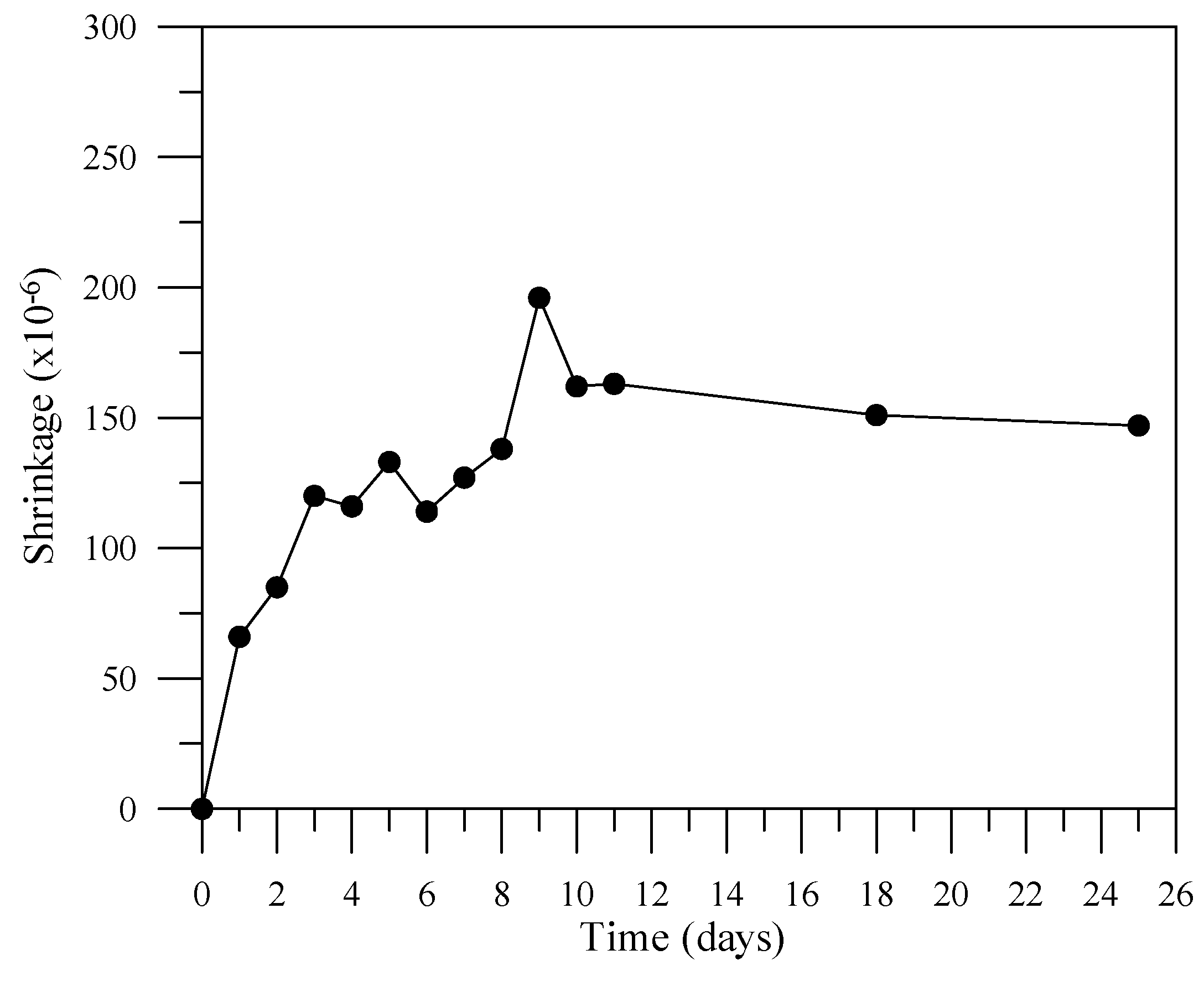
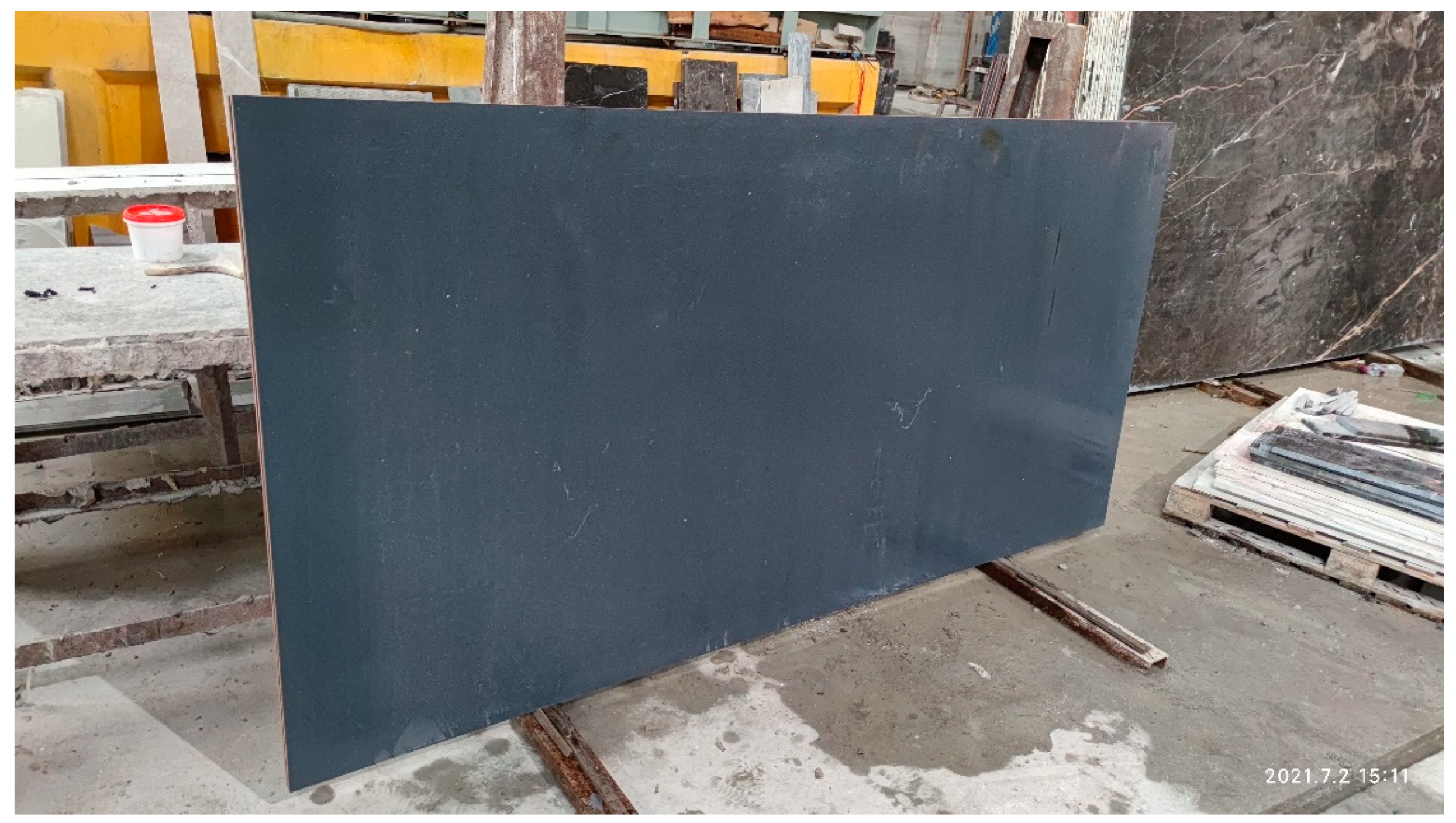
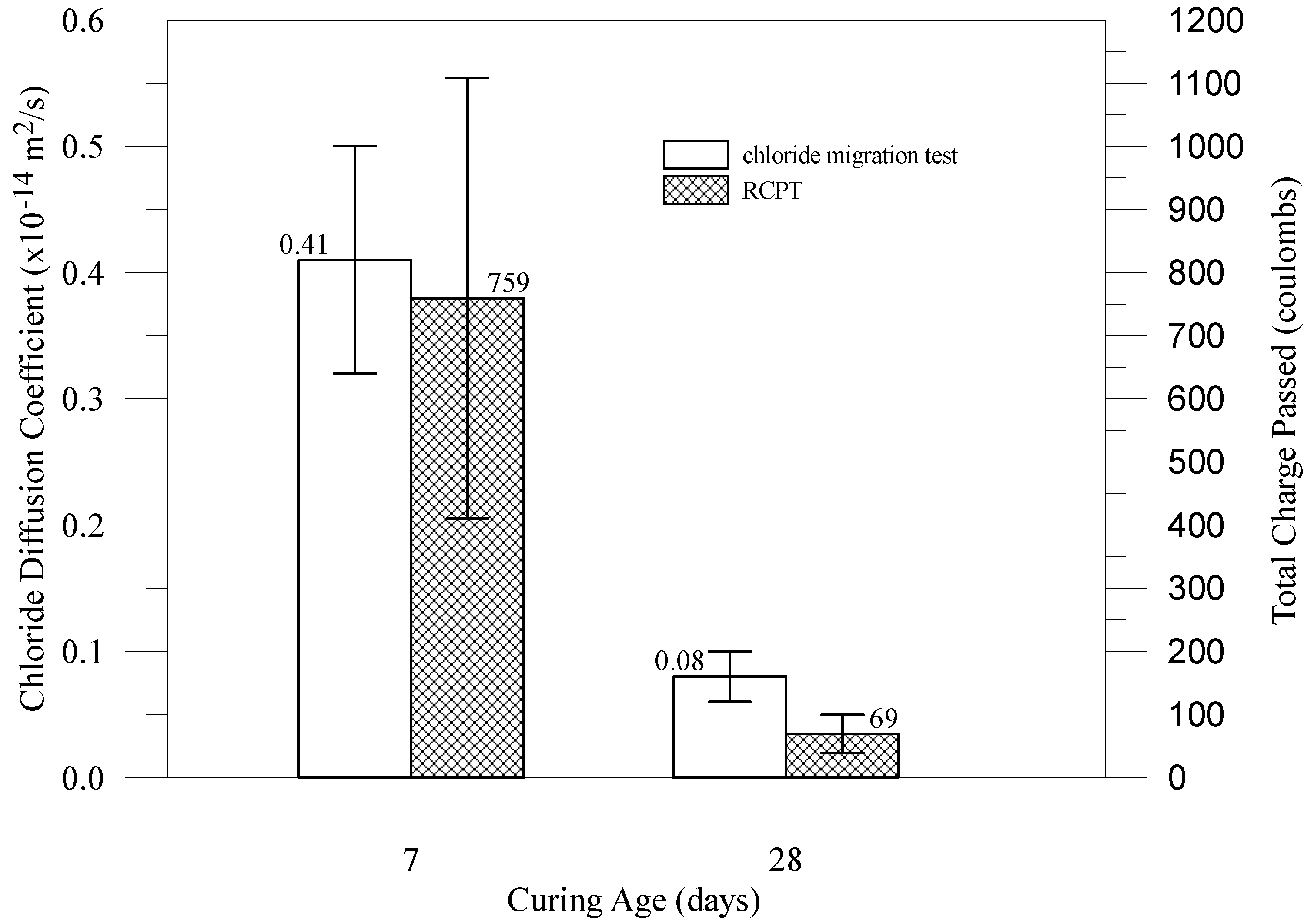

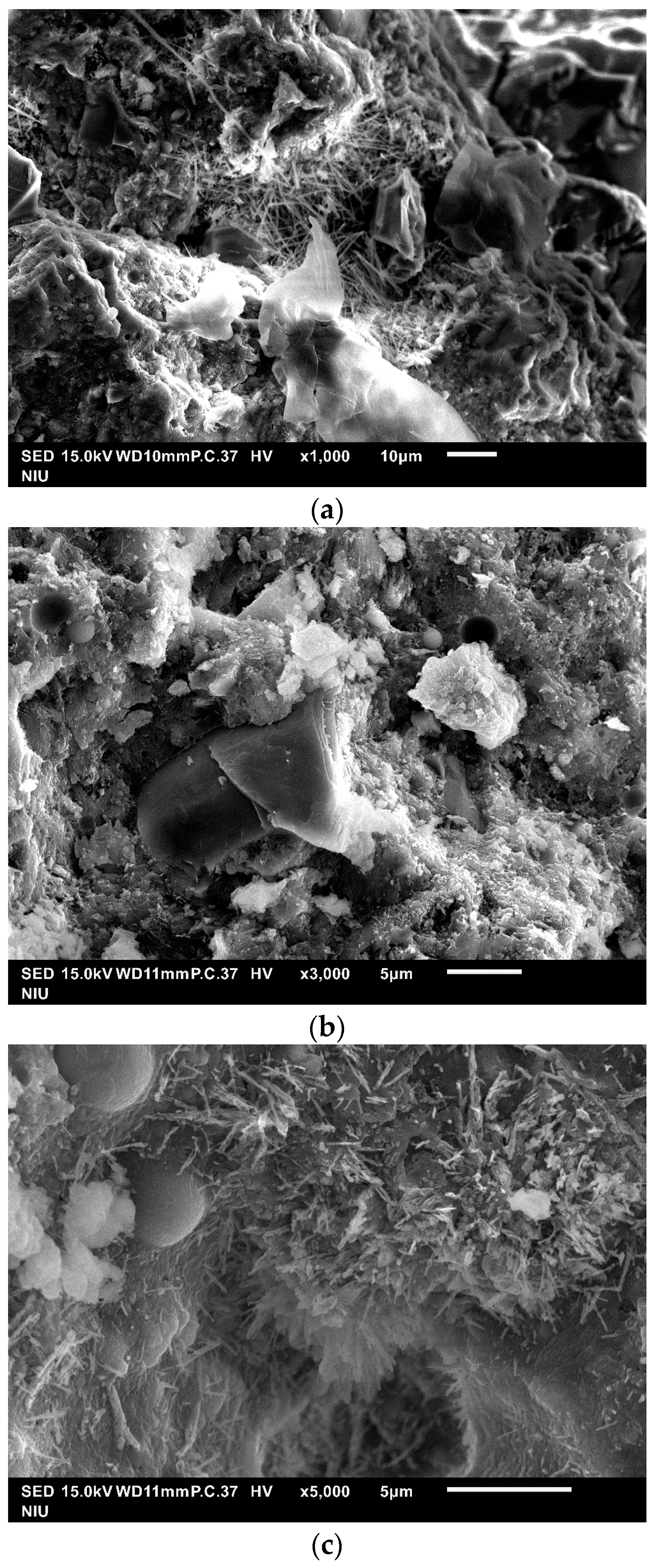
| Chemical Composites | Portland Cement | Sulphoaluminate Cement | Silica Fume | RUFA |
|---|---|---|---|---|
| Content (wt. %) | ||||
| SiO2 | 20.47 | 8.75 | 94.40 | 44.66 |
| Al2O3 | 4.54 | 33.80 | 0.53 | 24.83 |
| Fe2O3 | 3.28 | 1.76 | 0.14 | 6.18 |
| CaO | 63.47 | 42.95 | 1.35 | 12.47 |
| MgO | 2.18 | 1.91 | 0.48 | 4.22 |
| SO3 | 2.36 | 8.11 | 1.02 | 0.18 |
| others | 3.70 | 2.72 | 2.08 | 7.46 |
| Water | Portland Type II Cement | Sulphoaluminate Cement | Silica Fume | RUFA | PS | Fine Aggregates |
|---|---|---|---|---|---|---|
| 224 | 880 | 40 | 70 | 80 | 10 | 920 |
| Test Target | Specimen Dimensions (mm) | Referenced Standard | Testing Age (Days) | Curing Conditions | |
|---|---|---|---|---|---|
| Fresh properties | Slump-flow test | – | ASTM C1437 | – | – |
| Mechanical properties | Compressive strength test | 50 × 50 × 50 | ASTM C109 | 1, 3, 7, 14, 28 | Air and water |
| Flexural strength | 40 × 40 × 160 | ASTM C348 | 7, 28 | Air and water | |
| Expansion test | ϕ 50 × 100 | - | 1~28 | Air | |
| Abrasion test | 300 × 300 × 100 | ASTM C779 | 28 | Air | |
| Drying shrinkage test | 285 × 25 × 25 | ASTM C596 | 2~28 | Air | |
| Permeability | Non-Steady-state chloride migration test | ϕ 100 × 50 | NT Build 492 | 7, 28 | Water |
| RCPT | ϕ 100 × 50 | ASTM C1202 | 7, 28 | Water | |
| Microstructure observations | SEM observation | 10 × 10 × 3 | ASTM C1723 | 28 | Water |
| MIP test | 10 × 10 × 3 | ASTM D4404 | 28 | Water | |
| Time (min) | Slump-Flow (mm) 1 | ||||||
|---|---|---|---|---|---|---|---|
| 1 | 2 | 3 | 4 | 5 | Average | Standard Deviation | |
| 0 | 323 | 318 | 313 | 320 | 316 | 318 | 3.41 |
| 15 | 265 | 257 | 257 | 257 | 260 | 259 | 3.12 |
| 30 | 246 | 244 | 244 | 246 | 245 | 245 | 0.89 |
| 45 | 228 | 225 | 224 | 227 | 226 | 226 | 1.41 |
| 60 | 216 | 213 | 213 | 218 | 213 | 215 | 2.06 |
| Age | Abrasion Rate | Standard Deviation |
|---|---|---|
| 7 days | 0.506% | 0.002% |
| 28 days | 0.512% | 0.005% |
Publisher’s Note: MDPI stays neutral with regard to jurisdictional claims in published maps and institutional affiliations. |
© 2021 by the authors. Licensee MDPI, Basel, Switzerland. This article is an open access article distributed under the terms and conditions of the Creative Commons Attribution (CC BY) license (https://creativecommons.org/licenses/by/4.0/).
Share and Cite
Lin, W.-T.; Zhao, W.-Q.; Chang, Y.-H.; Yang, J.-S.; Cheng, A. The Effect of Incorporating Ultra-Fine Spherical Particles on Rheology and Engineering Properties of Commercial Ultra-High-Performance Grout. Crystals 2021, 11, 1040. https://doi.org/10.3390/cryst11091040
Lin W-T, Zhao W-Q, Chang Y-H, Yang J-S, Cheng A. The Effect of Incorporating Ultra-Fine Spherical Particles on Rheology and Engineering Properties of Commercial Ultra-High-Performance Grout. Crystals. 2021; 11(9):1040. https://doi.org/10.3390/cryst11091040
Chicago/Turabian StyleLin, Wei-Ting, Wen-Que Zhao, Yi-Hua Chang, Jiann-Shi Yang, and An Cheng. 2021. "The Effect of Incorporating Ultra-Fine Spherical Particles on Rheology and Engineering Properties of Commercial Ultra-High-Performance Grout" Crystals 11, no. 9: 1040. https://doi.org/10.3390/cryst11091040






